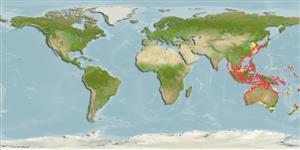Common names from other countries
Classification / Names / Names
Nomi Comuni | Sinonimi | Catalog of Fishes (gen., sp.) | ITIS | CoL | WoRMS
Environment: milieu / climate zone / depth range / distribution range
Ecologia
; distribuzione batimetrica 0 - 80 m (Ref. 348), usually 0 - 30 m (Ref. 348). Tropical
Indo-West Pacific.
Length at first maturity / Size / Peso / Age
Maturity: Lm ? range ? - ? cm Max length : 14.0 cm ShL maschio/sesso non determinato; (Ref. 348); common length : 11.0 cm SL maschio/sesso non determinato; (Ref. 348)
Shell thin, medium to large sized (commonly exceeding to 10 cm in length), laterally compressed, almost circular in outline, gaping anteriorly and posteriorly. Both valves somewhat convex, the right (lower) valve only a little more inflated and larger than the left (upper) valve. Ears small, subequal in size and shape, with the right anterior ear faintly sinuated at anteroventral margin and devoid of ctenolium. Surface of left valve with 2 broad and very shallow depressed areas radiating from the umbo to anteroventral and radial lines. Interior of both valves with distinct radial ribs, usually in pairs, much narrower than the flat interspaces and becoming obsolete on umbonal area. Right valve with 42 to 54 internal radial ribs (46 to 54 in the typical subspecies A. japonicum, and 42 to 48 in the southern A. japonicum balloti). Colour: outside of left valve reddish brown, with variable shades along the concentric growth marks; outer colour pattern of subspecies balloti also with small, yellowish and dark brown spots along radial lines on umbonal area and often with a few irregular, larger dark spots towards periphery. Interior of left valve glossy to pale yellow externally and internally; subspecies balloti with an additional external brown scattering along some concentric growth marks.
On sandy to muddy bottoms of lagoons, often associated with brown seaweeds. Sublittoral mainly from shallow waters to about 30 m, but also deeper to more than 80 m. Can actively swim by clapping the valves when disturbed, with a speed of about 2 knots and for a distance of some 10 m (Ref. 348).
Life cycle and mating behavior
Maturità | Riproduzione | Deposizione | Uova | Fecundity | Larve
Sexes separate. Spawning occurs in the cool season, from June to November. Growth is relatively rapid (about 7 to 8 cm in the first year), but the number of individuals reaching a 3 or 4 years age is small, because of a high rate of natural mortality.
Poutiers, J.M. 1998. (Ref. 348)
IUCN Red List Status (Ref. 130435)
CITES status (Ref. 108899)
Not Evaluated
Not Evaluated
Threat to humans
Harmless
Human uses
Pesca: commerciale
| FishSource |
Strumenti
Informazioni ulteriori
Age/SizeAccrescimentoLength-weightLength-lengthMorfologiaLarveAbbondanza
Fonti Internet
Estimates based on models
Preferred temperature
(Ref.
115969): 18.7 - 29, mean 27.6 (based on 1304 cells).
Vulnerability
Low vulnerability (10 of 100).
